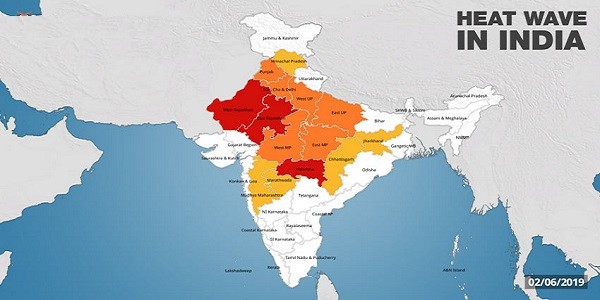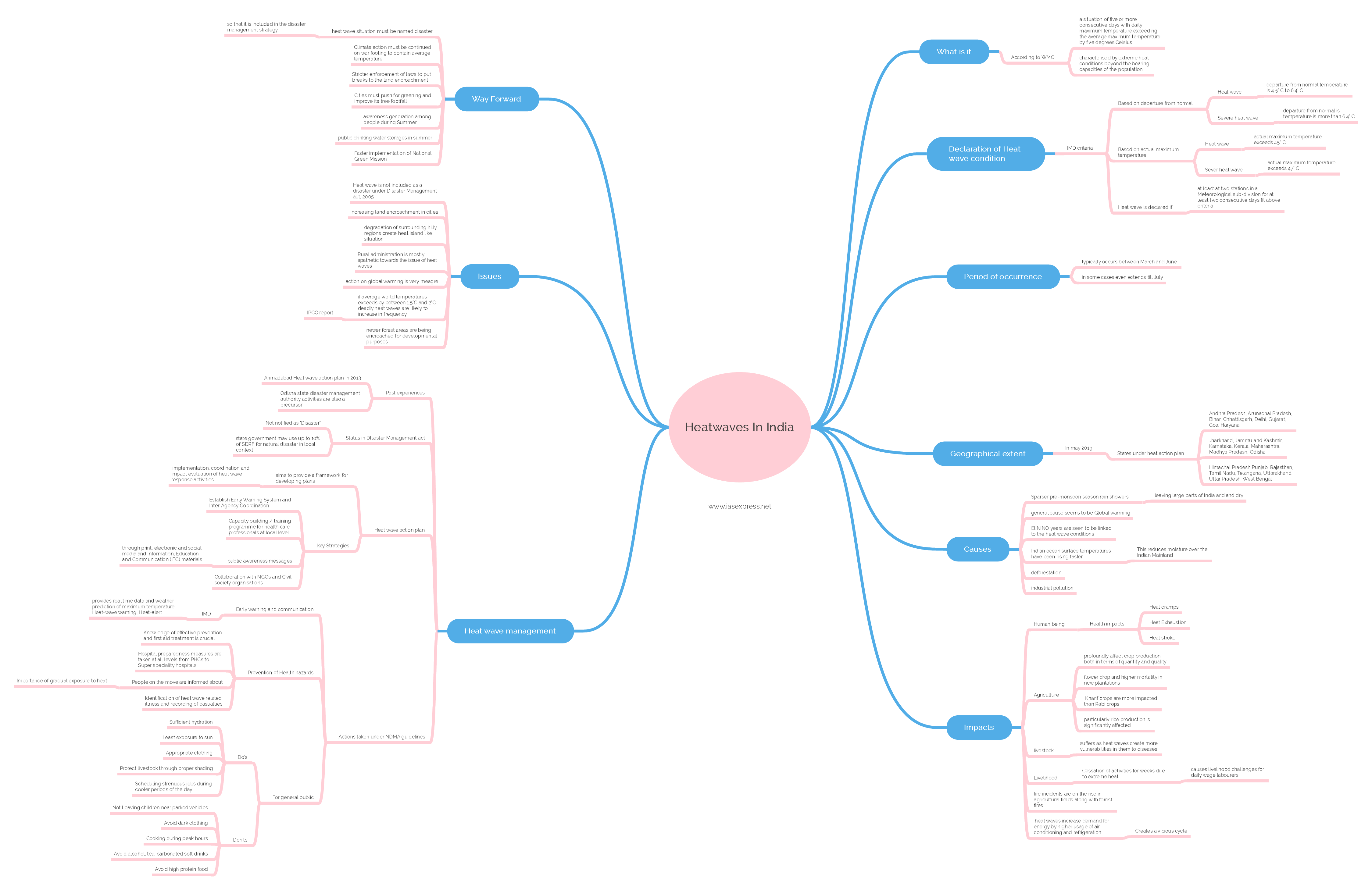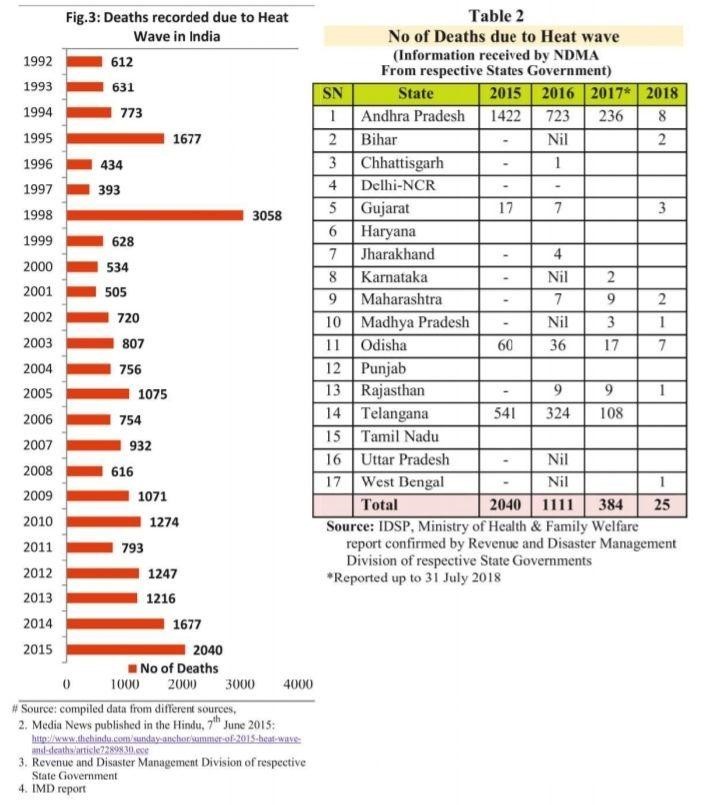[Disaster Series] Heatwave in India and its Management

Heatwaves emerged as one of the major weather hazards in India. In 2019, 19 states were affected by the phenomenon. Consequently, there is an urgent need to evaluate impacts of the heatwave and plan adaptation and mitigation strategies for prevention, preparedness and community outreach to safeguard human life, livestock, and wildlife.
What is a heatwave?
- A heatwave is a situation of five or more consecutive days with daily maximum temperature exceeding the average maximum temperature by five degrees Celsius (WMO).
- It is characterised by extreme heat conditions beyond the bearing capacities of the population.
When a heatwave condition is declared?
The criteria followed is given below
Based on departure from normal
- Heatwave- If the departure from normal temperature is 4.5° C to 6.4° C
- Severe heatwave- If the departure from normal is temperature is more than 6.4° C
Based on actual maximum temperature
- Heatwave- When the actual maximum temperature exceeds 45° C
- Severe heatwave- When the actual maximum temperature exceeds 47° C
When at least at two stations in a Meteorological sub-division for at least two consecutive days fit above criteria, heatwave condition is declared.
Period of Heatwave occurrence
The phenomenon of Heat Waves typically occurs between March and June and in some cases even extends till July.
What is the geographical extent of heatwaves in India?
The heatwave affects a large part of India. In May 2019, the following states were under the heat action plan-
Andhra Pradesh, Arunachal Pradesh, Bihar, Chhattisgarh, Delhi, Gujarat, Goa, Haryana, Himachal Pradesh, Jharkhand, Jammu and Kashmir, Karnataka, Kerala, Maharashtra, Madhya Pradesh, Odisha, Punjab, Rajasthan, Tamil Nadu, Telangana, Uttarakhand, Uttar Pradesh, West Bengal.
What are the causes of heatwaves?
- Sparser pre-monsoon season rain showers in many areas are leaving large parts of India arid and dry. This creates conditions of a substantial increase in temperature.
- The general cause seems to be Global warming but heatwave is very geography specific, so the relation is not clear yet.
- The El NINO years are seen to be linked to the heatwave conditions.
- The Indian ocean surface temperatures have been rising faster than other oceans. This reduces moisture over the Indian Mainland, resulting in long hot days.
- The ever-increasing deforestation, industrial pollution are some of the causes of rising average temperatures.
What are the impacts of Heatwaves?
Effects on human beings
- The health impacts of heatwaves include the following
- Heat cramps- swelling, fainting, accompanied by fever
- Heat Exhaustion- weakness, dizziness, headache, nausea, fatigue, sweating and muscle cramps.
- Heat Stroke- Delirium, seizures, coma. Heatstroke is a potentially fatal condition.
- The number of deaths has been increasing due to heatwaves –
- Impact on Agriculture
- Heat Wave has also been found to profoundly affect crop production both in terms of quantity and quality.
- crop loss is encountered due to flower drop and higher mortality in new plantations. Kharif crops are more impacted than Rabi crops owing to variability in rainfall associated with Heat Wave.
- Within Kharif, particularly rice production is significantly affected with decreased grain yield which is a matter of concern as rice is a staple diet in many States experiencing heatwave impacts.
- The livestock also suffers as heat waves create more vulnerabilities in them to diseases.
- Impact on Livelihood
Cessation of activities for weeks due to extreme heat causes livelihood challenges for daily wage labourers.
- The fire incidents are on the rise in agricultural fields along with forest fires due to higher average temperatures.
- The heat waves increase the demand for energy by higher usage of air conditioning and refrigeration. This creates a vicious cycle of heatwaves leading to higher greenhouse gas emission and that leading to higher average temperatures.
Heatwave management
Past experiences
- Ahmadabad in 2013 implemented Heatwave action plan which outlined several interventions such as public awareness, community outreach, capacity building of medical community, reducing heat exposure and promoting adaptive measures.
- Odisha State Disaster Management Authority has taken steps such as early warning, public outreach, Medical up-gradation, etc.
Heatwave and Disaster Management
- Heatwave is not notified as a disaster by the government of India yet.
- However, a state government may use up to 10% of SDRF for natural disasters in the local context.
What is the Heatwave action plan?
The Heatwave action plan aims to provide a framework for developing plans for implementation, coordination and impact evaluation of heatwave response activities.
Key strategies of the Heat Wave action plan–
- Establish an Early Warning System and Inter-Agency Coordination.
- Capacity building/training programme for health care professionals at a local level to recognize and respond to heat-related illnesses, particularly during extreme heat events.
- Disseminating public awareness messages on how to protect against the extreme heat-wave through print, electronic and social media and Information, Education and Communication (IEC) materials.
- Collaboration with non-governmental organizations and civil society organizations to improve bus stands, building temporary shelters, etc.
What are the steps taken in tackling Heatwave?
The NDMA guidelines on Heatwave management are as follows
Early Warning and communication
- The IMD is mandated to provide current and forecast meteorological information for optimum operation of weather-sensitive activities.
- It provides real-time data and weather prediction of maximum temperature, Heat-wave warning, Heat-alert.
The colour code indication by IMD
Prevention of health-related hazards
- Health-related illness is preventable. Knowledge of effective prevention and first aid treatment is crucial.
- Hospital preparedness measures are taken at all levels from PHCs to Super specialty hospitals.
- People on the move are informed about the importance of gradual exposure to the hot environment during heatwave condition
- Identification of heatwave related illness and recording of casualties.
Dos for the general public
- Sufficient hydration
- Least exposure to the sun
- Appropriate clothing
- Protect livestock through proper shading
- Scheduling strenuous jobs during cooler periods of the day
Don’ts for the general public
- Not Leaving children near parked vehicles
- Avoid dark clothing
- Cooking during peak hours
- Avoid alcohol, tea, carbonated soft drinks
- Avoid high protein food
What are the issues related to heatwave management?
- The heatwave though takes 100s of lives every passing year, it is not included as a disaster under the Disaster Management act, 2005.
- Increasing land encroachment in cities and degradation of surrounding hilly regions create heat island like situation which exacerbates the condition of heatwaves.
- Rural administration is mostly apathetic towards the issue of heatwaves.
- The action on global warming is very meagre.
- According to IPCC, if average world temperatures exceed by between 1.5˚C and 2°C, deadly heatwaves are likely to increase in frequency.
- Deforestation is not slowing down. Rather, newer forest areas are being encroached for developmental purposes.
Way forward
- The heatwave situation must be named disaster so that it is included in the disaster management strategy.
- Climate action must be continued on war footing to contain average temperature.
- Stricter enforcement of laws to put breaks to the land encroachment.
- Cities must push for greening and improve their tree footfall.
- Creating awareness among people during Summer.
- Putting public drinking water storages in summer.
- Faster implementation of National Green Mission.
Practice Question for Mains
What is a heatwave? Discuss its causes and impacts. (250 words)
If you like this post, please share your feedback in the comments section below so that we will upload more posts like this.




IMD – declares Heatwave situation in India – based on several criteria – Heat Wave need not be considered till the maximum temperature of a station reaches at least 40°C for Plains and at least 30°C for Hilly regions. When the normal maximum temperature of a station is less than or equal to 40°C, Heat Wave Departure from normal is 5°C to 6°C and Severe Heat Wave Departure from normal is 7°C or more. When the normal maximum temperature of a station is more than 40°C, Heat Wave Departure from normal is 4°C to 5°C and Severe Heat Wave Departure… Read more »
🔥NOBODY has POWER to STOP Climate Changes🔥 💥💥We CANNOT Prevent Global Warming💥💥 🔥The temperature of Earth’s CORE is about 5500°C just as much as the temperature of the Sun’s Surface❗The STRONGEST Nuclear Power in the world is the EARTH❗The Earth’s extremely HOT MOLTEN CORE has the POWER equal to BILLIONS of Nuclear Bombs‼️ 💥ALL the Scientists, Leaders, Governments and People of the World together CANNOT CONTROL or STOP the POWERFUL FORCES of the Earth, which cause Natural Calamities, Climate Changes, Global Warming, Heat Waves, Wild Fires, Cyclones, Heavy Rains and Floods, Earthquakes and Volcanoes, etc. 💥All the People of… Read more »